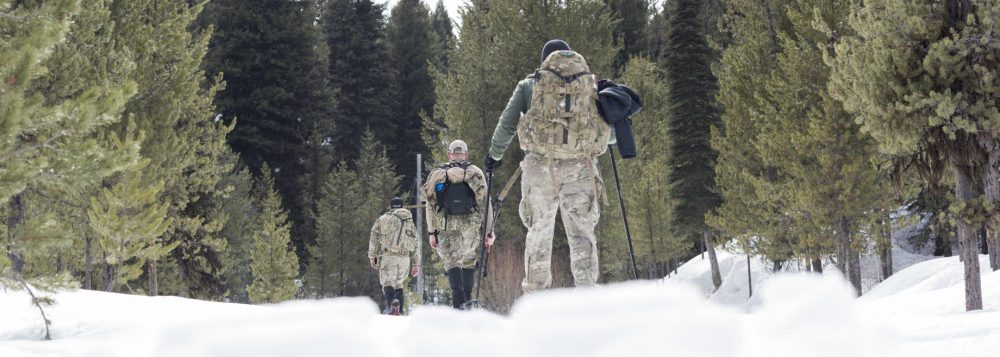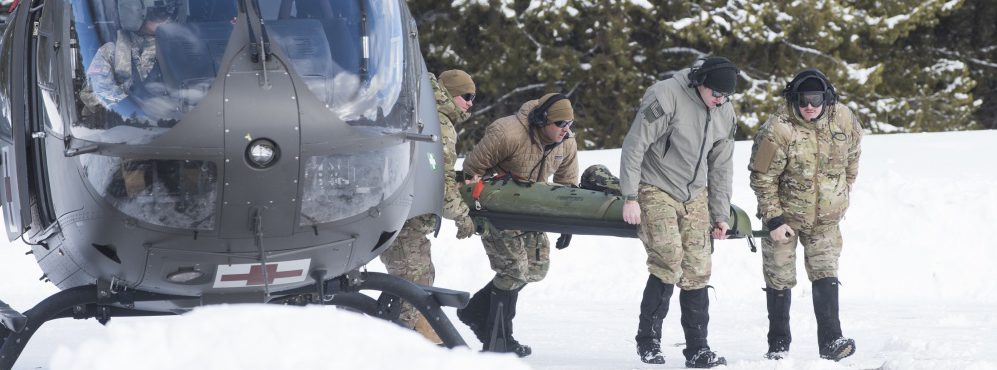Category: Air National Guard
Missing in Idaho – A lost hiker training scenario

BOISE AIR TERMINAL AIR GUARD STATION, ID, UNITED STATES
03.13.2019
Story by Master Sgt. Becky Vanshur
124th Fighter Wing
CASCADE, Idaho – Imagine there is a missing hiker in the snow-covered mountains. The Idaho Air National Guard’s 124th Air Support Operations Squadron is called for assistance with local northern Idaho search and rescue teams. This is the second year of this specific training with state authorities for possible rescue missions involving the IDANG here on March 7-9, 2019.
Friday, March 7 at 11:32 a.m.
The call comes in. Idaho Emergency Dispatchers notify the Air Force Rescue Coordination Center, the single agency responsible for coordinating federal search and rescue activities, with a request deemed necessary for military assistance. A missing hiker is reported to possibly be lost in the mountains near Horse Thief Reservoir. The hiker was due home by 11:00 p.m. that previous night and all communication was lost as of 8:00 p.m., Thursday evening, three hours earlier. The incident was reported the following morning.
Time is of the essence.
It is just minutes past noon. The Airmen from the 124th ASOS’s Tactical Air Control Party have gathered their response team and their equipment. A convoy of their vehicles leave the gates of Gowen Field to begin the two hour drive north to assist with the search mission.
2:00 p.m.
With the weather calm and clear, a surveillance search and rescue aircraft has been called and is circling the area with specialized thermal imaging systems, equipped with GPS and laser rangefinder to enable precise geolocation.
A large parking lot near Horse Thief Reservoir quickly becomes the search and rescue incident response center. The Idaho TACPs have set up their communications vehicle with an elevated antenna mast for air-to-ground and ground-to-ground radio communications. A TACP makes contact with the aircraft. “The missing person is a 48-year-old male wearing a gray sweatshirt. Last known whereabouts were hiking in the hills south of Horse Thief Reservoir roughly 18 hours ago.”
The Valley County Search and Rescue’s team leader describes the area he wants searched. The air controller wastes no time translating to the aircraft. “Condor, this is Vandal. At grid November-Kilo-271356 you should see a hilltop, with a 30 meter clearing, no trees. From this hilltop, perform a circular search pattern in a 500-meter radius, working outward.”
The aircraft is equipped with a specialized system, Remotely Operated Video Enhancer Receiver (ROVER), which transmits the digital video feed down to the TACP’s tablet. The aircraft will switch between a television camera picture and thermal infrared radiation picture, which detects longer wavelengths of thermal energy invisible to the human eye. Condor’s search is on, while the ground teams watch the video and further direct the camera.
3:07 p.m.
The ROVER video has found a thermal spot similar to that of a person’s size. The aircraft calls it in. “I have a heat signature under some trees, no movement, possible shape and size of a person.” A precise grid location immediately follows and the radio chatter between ground stations begins.
Already standing by, the initial search team heads out. Two individuals from Valley County Search and Rescue, and two from the 124th ASOS use snowmobiles and tracked all-terrain vehicles to make their way up the mountain. The TACPs utilize GPS receivers with paper and digital maps essential for navigating this mountainous terrain.
3:40 p.m.
Team 2 remains at the Horse Thief Reservoir incident response center, anticipating possible extraction scenarios and preparing appropriate equipment. Communication continues back and forth between the aircraft, the incident response cell and the initial search team. The initial search team is close, but the terrain has required them to proceed on foot down a near-vertical cliff face. Minutes continue to pass, hands clenching tightly to the radios.
3:49 p.m.
The initial search team has located the missing hiker, and team 2 is mobilized over the radio. “Copy. The individual has been found. One male, gray sweatshirt, around 48-years-old and is unresponsive, could have a possible head injury. Requesting team 2 for extraction, bring the hoist stretcher, SKED and ropes systems. Bring medical assistance.” The initial search team is accessing the individual but has requested the additional medic.
Every minute counts.
Team 2 sets out on foot. Valley County Search and Rescue’s search dog is sniffing the ground and air, determined. The snowshoes of two ski patrollers and the team of six TACPs trekking at a very fast pace, hauling the requested equipment and making their way straight to the location of the initial search team. They continue off road, hiking straight up steep terrain, cutting valuable minutes off the clock.
4:00 p.m.
Team 2 arrives, the medic assesses the patient while the TACPs locate a suitable helicopter landing zone. He needs immediate medical assistance at the nearest hospital. The request for a rescue helicopter is made. The two teams, working quickly together to load and strap the patient to a backboard-SKED combination, while others build a pulley system used to haul the patient up a 25-foot cliff face to an open patch of ground suitable for a landing zone. The extra military manpower has saved precious time. The patient is handed off to the rescue snowmobile team, heading toward the landing zone for Life Flight Network assistance.
In this scenario, the local Life Flight helicopter would respond, but if a special extraction hoist is necessary for extreme terrain, the Idaho Army National Guard’s UH-72 Lakota Rescue Helicopter could be called and ready to respond within hours to transport a patient.
4:27 p.m.
With the help of the Idaho Air National Guard’s 124th ASOS, in this training scenario, the lost hiker was successfully found, rescued and a life was saved.
Local civilian search and rescue teams present for this joint training included Valley County Search and Rescue, Cascade Fire Department, McCall Fire Department, Tamarack Ski Patrol and Bogus Basin Ski Patrol.
The Traditional: A Pile of hope for Idaho’s youth

BOISE, ID, UNITED STATES
11.02.2018
Story by Airman 1st Class Taylor Walker
124th Fighter Wing
It’s Saturday. Airmen pack themselves along a wall outside the base cafeteria as they exhaustedly shuffle along toward a dry erase board. Eyes scan the board and land on colored letters that read JALAPEÑO POPPERS. The closest Airman quietly celebrates.
“Drill can be tedious,” said Tech. Sgt. Mario A. Pile. “If people can have at least one good meal, then people are happy. That’s the biggest thing for me; I get to be part of that bright spot on a tedious drill weekend.”
Pile, the NCO in charge of the 124th Force Support Squadron Services Flight, dedicates his time to creating welcoming environments for people around him because he believes in building bridges between colleagues and those in need.
“Even as a traditional guardsman, he spends time communicating with the people he supervises outside of drill weekend, checking in on them and seeing how they’re doing,” said Senior Master Sgt. Amethyst R. Keaten, the 124th FSS base services superintendent. “That’s the guy you want on your team.”
Pile’s people-oriented disposition doesn’t stop with his role in the Idaho Air National Guard. As the full-time program manager for the Idaho Youth Ranch Hays House, Pile is responsible for overseeing a homeless shelter for youth ages 9-18.
“I manage chaos,” said Pile. “Everything that might go on with a kid, from school to therapy to casework to listening to them cry, I manage all of that.”
When it comes to a high-stress environment and the welfare of others, Keaten said Pile’s multifaceted approach to problems elevates his success in both his military and civilian careers.
“He’s able to take a situation and look at in a multitude of ways versus just one way,” said Keaten. “He does that with a lot of willingness and ability to empathize and put himself in another person’s shoes. That level of thoughtfulness and care helps him to be very well-suited for what he does at the Hays House and what he does (in the Air National Guard).”
Hays House provides a home to nearly 100 kids each year and is the valley’s only shelter for runaways and homeless kids who are victims of abuse or neglect. To parents who have a hard enough time managing the schedules and development of their own children, Pile’s dedication to Idaho’s homeless kids seems like the work of a superhero. Although fans like Keaten say he shines on a regular basis, Pile disagrees.
“I don’t do anything unique or super special,” said Pile. “I listen and I try to smile and greet the kids. It’s a lot of the small things.”
Pile, who has also worked for the Idaho Youth ChalleNGe Academy, said he’s driven by the opportunity to influence how youth in Idaho are treated. While Hays House provides food, shelter and important resources 24 hours a day, he emphasizes that the best way for anyone to help a kid is by taking the time to mentor them. The key, Pile said, is to slow down and truly listen to and understand what they have to say.
“Just because a kid is labeled as at-risk doesn’t mean they’re a bad kid,” said Pile. “If every adult could see that an at-risk youth is not a bad kid, maybe we’d show more empathy. We need more empathy. Not more efficiency. Not more doing things quickly. We need more empathy.”
ASOS Airmen Preparing and Training for State Emergency Response

BOISE AIR TERMINAL AIR GUARD STATION, ID
03.08.2018
Story by Master Sgt. Becky Vanshur
CASCADE, Idaho – Envision a scenario where the crash of an avalanche has left several people missing, or you are skiing in the mountains and lose sight of your buddy. Visualize it’s you that is lost off-trail, hoping to be rescued, waiting for the sound of helicopter blades pulsating in the air or the sound of voices ahead. This is the mission of search and rescue teams – to find you.
In an effort to begin rescue missions with civilian and state entities, Idaho’s 124th Air Support Operations Squadron (ASOS) conducted its first-ever training event that involved approximately 70 civilians from local rescue teams in Cascade, Idaho, March 1-4, 2018. The goal for this integrated training was to take the skills used in the federal mission and apply those capabilities for the Defense Support of Civil Authorities (DSCA).
“I feel like we are moving into a domestic operations concept. We’ve been at war for a long time, we’ve been deploying for a long time, we want to enlarge our footprint,” said 1st Lt. Jason Waites, 124th ASOS, officer in charge of operations. “We want to roll into the DSCA and establish the ASOS as a state entity.”
The Idaho Air National Guard’s ASOS, specifically the Tactical Air Control Party (TACP) Airmen, have endured intense physical, mental and technical training. They are experienced in extensive outdoor training, survival skills, Rough Terrain Evacuation Course, Wilderness First Responder training, and mountain warfare. Additionally, they have the equipment available for helping with search and rescue missions.
“This training for us is like a proof of concept that we will be able to advertise our capabilities to the state, that this is what we have the ability to do. When that emergency goes out, we can come to help. TACPs from neighboring states have pre-packaged communications systems set up and have helped with mudslides and fires because of the night vision and thermal capability of finding people in the dark,” said Chief Master Sgt. Mike Furman, chief enlisted manager of ASOS. “These other states have coordinated helicopter landing zones, helped with post hurricane and flood response already. Although we haven’t been called upon yet, we just want to make sure we are ready for when the call comes.”
The goal of this joint engagement was to work alongside civilian authorities during avalanche rescue training, snowmobile training, sling load training, and stretcher hoist rescue training, along with the Idaho Army National Guard 1-183rd Aviation Battalion’s UH-72 Lakota Rescue Helicopter.
“We weren’t really aware, until today, how accessible you guys [ASOS] were,” said Dan Corsberg, Garden Valley Fire Department. “To know it could be an hour, hour and a half, for you guys to be on scene. That really does change the equation for us, a lot. That has been the biggest take-away for us with this training.”
Local civilian search and rescue teams present for this joint training included: the McCall Police Department, McCall Fire Department, Cascade Fire Department, Donnelly Fire Department, Garden Valley Fire Department, Valley County Search and Rescue, Valley County Sheriff’s Office, Boise County Sheriff’s Office, Adams County Sheriff’s Offices, Bogus Basin Ski Patrol, Brundage Ski Patrol, Tamarack Ski Patrol, Idaho Fish and Game, and the U.S. Forest Service.
The training was focused on everything from search and rescue, to command and control, to effectively testing communications. When it comes to the Federal Emergency Management Agency, there are Emergency Support Functions (ESF). ESF number nine is search and rescue related, and ESF number two is communications. This exercise effectively tested command and control with air-to-ground and ground-to-ground communications.
“These guys know what they are doing, and it’s been great. We are all learning from each other. This is an incredible opportunity,” said Jim Pace, Valley County Search and Rescue.
 Official Government Website
Official Government Website